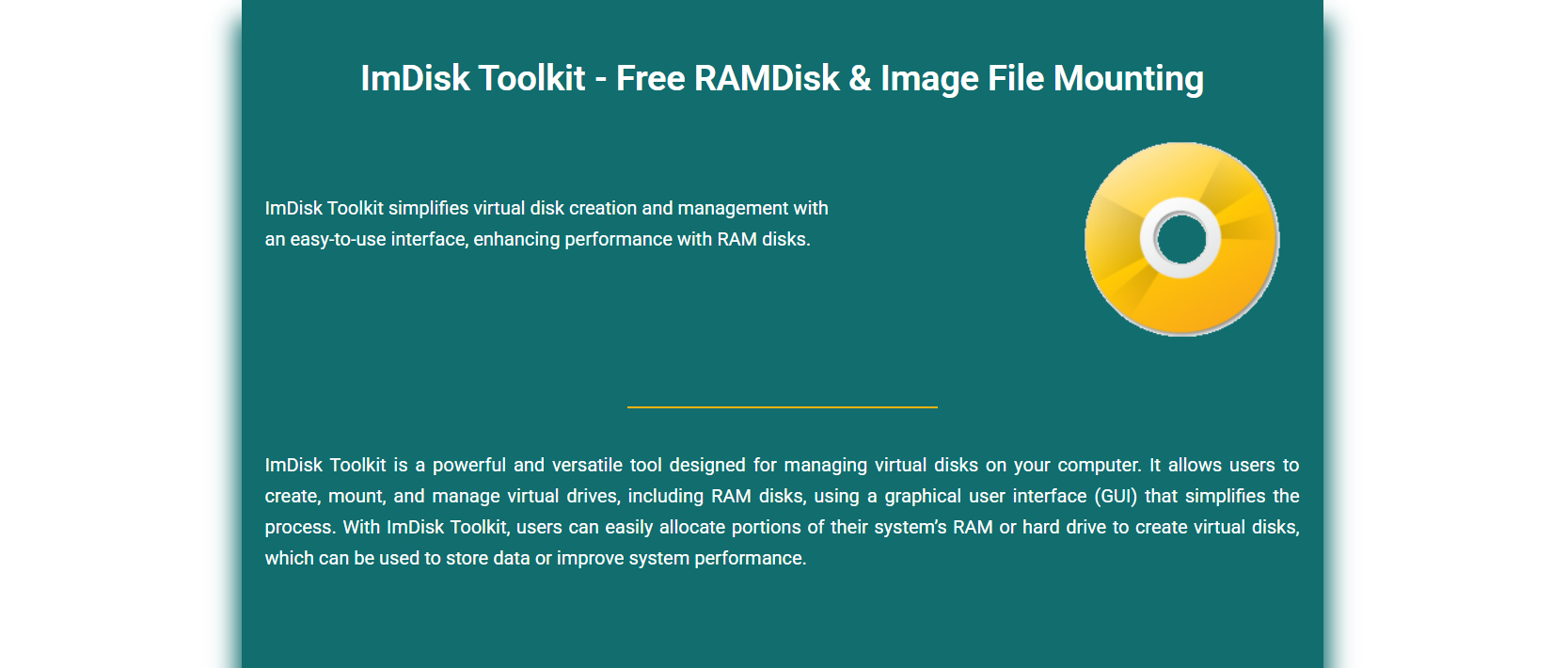Image files like ISO, IMG, and VHD are widely used for software distribution, disk backups, and virtualization. To interact with these files, users often require dedicated mounting tools that simulate a physical disk. This is where ImDisk Toolkit comes into play. As a lightweight, open-source solution, it allows users to mount various image formats directly onto their Windows systems without hassle.
Whether you’re a system administrator, a developer, or a regular PC user, the ability to access image file contents without burning them to a physical disk saves time and resources. ImDisk Toolkit provides this convenience with a simple, flexible interface that supports both graphical and command-line interactions. Its efficiency, format compatibility, and user-friendly features make it a reliable choice for mounting image files seamlessly.
Understanding Image File Mounting
Mount an Image File
Mounting an image file refers to the process of making the content of a disk image accessible as if it were a physical drive. Once mounted, the file appears in Windows Explorer with a drive letter, allowing users to explore or execute its contents. This eliminates the need for burning the image to an actual disk. Tools like ImDisk make this virtual drive creation smooth and instant.
Common Image File Types
The most commonly mounted image files include ISO (optical disc images), IMG (raw image files), and VHD (virtual hard disks). These formats are used for backups, software deployment, and OS installations. ImDisk supports a variety of these formats, enabling users to interact with different types of disk images without needing separate software for each type.
Mount Instead of Extracting
Mounting offers real-time access to an image file, preserving the file system structure and behavior. Extracting, in contrast, copies the content into a directory, which may alter permissions or boot configurations. For read-only or bootable setups, mounting is the preferred method, especially when testing operating systems or accessing secured software packages.
Using ImDisk Toolkit for Mounting
Getting Started with ImDisk
Installing ImDisk Toolkit is straightforward. Once downloaded, the installation includes both a graphical user interface and command-line utilities. After installation, users can right-click on an image file and select “Mount as ImDisk Virtual Disk” from the context menu. This ease of access simplifies the process even for users with limited technical knowledge.
Mounting an ISO File
To mount an ISO using ImDisk, users can use the GUI tool or File Explorer. Right-clicking the ISO and selecting the mount option brings it up as a virtual drive. Alternatively, users can launch the ImDisk Control Panel, browse to the ISO location, assign a drive letter, and mount it. The ISO then behaves like a CD/DVD inserted into a physical drive.
Mounting VHD and IMG Files
ImDisk also supports mounting VHD and IMG files. These formats often contain full disk or partition images. Similar to ISO mounting, users can select the image file, assign a drive letter, and choose mounting options such as read-only mode. This is especially useful for restoring backups or inspecting system images without modifying them.
Advantages of Mounting with ImDisk
Speed and Performance Benefits
ImDisk mounts image files instantly, without lengthy setup or emulation processes. It uses minimal system resources, making it ideal for quick access and temporary use. Unlike other bloated tools, ImDisk’s lightweight design ensures your system doesn’t slow down when mounting multiple image files at once.
Format Versatility
One of the strengths of ImDisk Toolkit is its wide format compatibility. Whether you’re working with ISO, IMG, VHD, or raw images, ImDisk handles them efficiently. This eliminates the need for multiple tools and simplifies workflows for IT professionals and advanced users alike.
Advanced Mounting Options
ImDisk offers several advanced settings such as read-only mode, offset configuration, and drive letter customization. These options are especially valuable for forensic analysis, OS testing, and troubleshooting. Users can tailor how each image behaves when mounted, offering more control than standard Windows tools.
Comparing ImDisk to Built-in and Third-Party Tools
How ImDisk Differs from Windows Explorer Mounting
While Windows 10 and 11 support ISO mounting natively, they lack support for IMG, VHD (with flexibility), and advanced features. ImDisk fills this gap by supporting a wider range of file types and customizable options. Users gain more flexibility, especially when dealing with complex or large image files.
ImDisk vs. Third-Party Alternatives
Compared to tools like Daemon Tools or PowerISO, ImDisk stands out for being open-source, lightweight, and free from ads or unnecessary bloatware. It’s favored by professionals who need reliable performance without distractions. ImDisk’s simplicity is its strength, offering just what’s needed and nothing more.
When to Use Each Tool
For casual users needing basic ISO mounting, Windows Explorer might be enough. However, for tasks involving multiple image formats, advanced settings, or forensic-level control, ImDisk is the superior choice. It provides the perfect balance between simplicity and power for technical workflows.
Conclusion
ImDisk Toolkit makes mounting image files fast, efficient, and highly customizable. With support for ISO, IMG, and VHD formats, it outperforms many built-in and third-party tools. Whether you’re managing backups, deploying systems, or exploring software packages, ImDisk provides the flexibility and control that professionals rely on.


